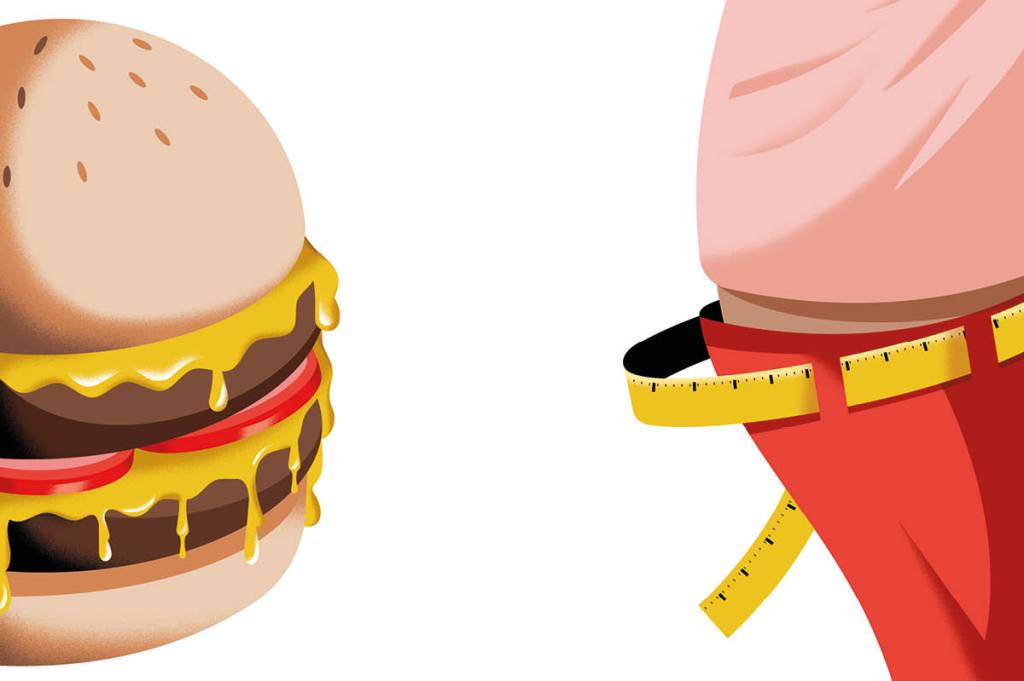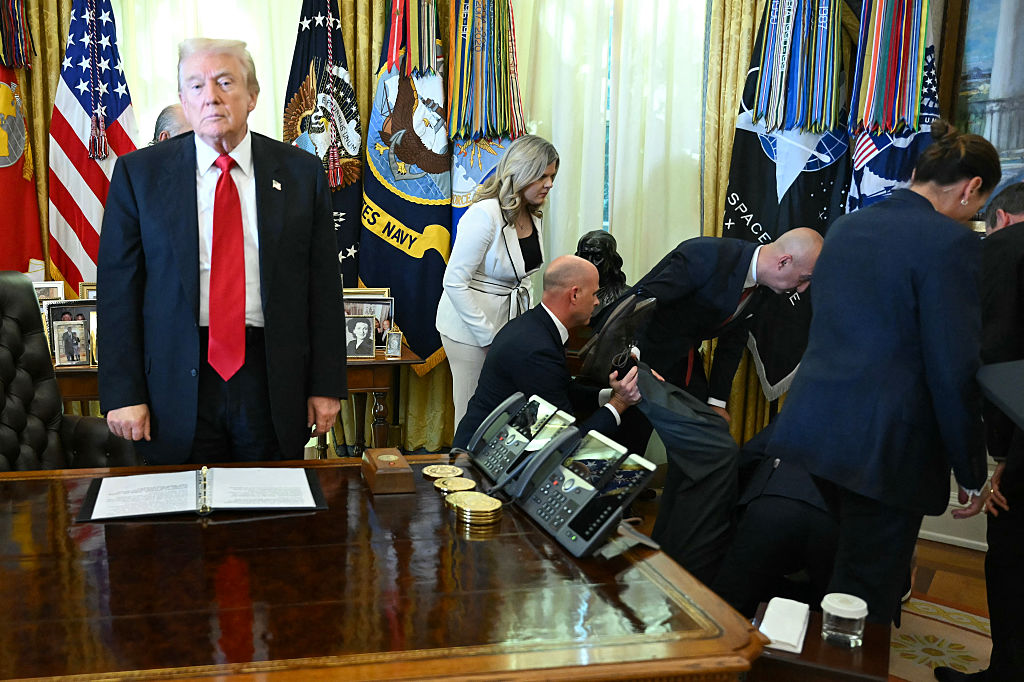Consume American media for more than five minutes, and sandwiched between advertisements for KFC $5 Fill-Ups and a dramatic Golden Corral short pondering the age-old question, “Chicken tenders or baby back ribs?,” you’re bound to behold at least a half-dozen ads for prescription drugs. They tend to last longer than the straight-to-the-glutton-button fast-food commercials, and they play over and over and over again (who doesn’t know the Oh, Oh, Oh, Ozempic! jingle by now?) — and airtime ain’t cheap.
“When Oprah Winfrey’s bombshell interview with Prince Harry and Meghan Markle aired in March 2021, the British tuned in, and many were gobsmacked at the number of drug commercials they saw,” Vox reported earlier this year. Some cite a lack of regulatory oversight for our uniquely American bounty of direct-to-consumer prescription drug ads. Yet regardless of why they’re allowed, drug companies wouldn’t spend upwards of $6 billion annually if sick consumers didn’t want their products, and drug companies wouldn’t have $6 billion to spend on ads in the first place if consumers weren’t already buying their drugs. Often, the drugs advertised (not just Ozempic) are to treated illnesses related to obesity.
When it comes to obesity rates, the United States, ahem, sticks out. More than 42 percent of US adults are considered obese (with a body mass index over thirty), and more than 30 percent are overweight (BMI over twenty-five). That amounts to more than two-thirds of the American population with some extra junk in the trunk. And with extra junk comes high blood pressure, sleep apnea, depression, diabetes, strokes, heart conditions — and that $6 billion prescription-drug advertising budget.
While the food, drug and healthcare industries profit wildly from this crisis, a campaign to stem the tide of chronic disease through healthy eating is underway.
“Our healthcare system incentivizes people to be sick,” says Calley Means, co-founder of TrueMed, a payment integration company that enables customers to use pre-tax health savings account and flexible spending account funds on healthy food, supplements and exercise-related costs. “If pharma and the healthcare industry were to design a perfect system, it would be that everyone’s getting sick from food and we’re not curing anything, and people are not dying quite yet, but we’re managing more and more conditions that are tied to food. That’s exactly the system we have… Their business model is charging people who need interventions.”
According to Means and other nutrition researchers, the path to America’s obesity crisis was, like the road to perdition, paved with good intentions. A century ago, before widespread refrigeration, innovators figured out a way to make foods more shelf-stable by replacing lard with agricultural and industrial byproducts (cottonseed oil) that had been hydrogenated. Corn, rapeseed (better known as canola), soy and other vegetable seeds were soon drafted to Team Oil, and Crisco and other vegetable-oil shortenings exploded on the American food scene.
In the 1970s, in a bid to stabilize food prices, President Richard Nixon authorized subsidizing corn crops; that glut in the market led to the development of high fructose corn syrup, which turned out to be much cheaper to produce than sugar. Today, it’s hard to go to the grocery store and find a package of anything that doesn’t contain seed oils or corn syrup. Cereals, chips, crackers and salad dressings are rife with both. I thought I was safe eating a handful of whole roasted cashews, but no: the label lists “vegetable oil (peanut, cottonseed, soybean and/ or sunflower seed).” Because seed oils are intensely subsidized, they’re very cheap. The American Action Forum reports, “The most heavily subsidized and produced crops — corn, soy and wheat — are key ingredients in highly processed foods and are consumed at an ever-growing rate.”
“A Coca-Cola on average is cheaper than a water because there are so many subsidized ingredients in there,” says Means. “These subsidies incentivize food to be really processed, and now close to 70 percent of the American diet consists of ultra-processed grains, seed oils and added sugar. Just as social media companies are studying how to keep us addicted to their platforms and keep our dopamine going, there are very sophisticated scientists at food companies who understand how to combine certain fats and sugar and make food literally addictive.”
In a 2013 article on “the extraordinary science of addictive junk food,” the New York Times reported on the phenomenon of “vanishing caloric density.” Using Cheetos as an example, food scientist Steven Witherly explained, “If something melts down quickly, your brain thinks that there’s no calories in it… you can just keep eating it forever.”
“Now eight of the ten leading causes of death in the United States are chronic diseases that are tied to food: diabetes, heart disease, dementia, Alzheimer’s and many forms of cancer,” Means says.
While the debate over food subsidies has been raging for some time, evidence suggesting seed oils may be partly to blame is just beginning to come to light. These oils are, after all, like our obesity epidemic, a modern phenomenon, and several nutrition researchers posit that the body isn’t designed to handle such highly refined foodstuffs. Processed foods are notoriously high in omega-6 fats, too, which cause inflammation and a host of associated chronic disorders.
Nina Teicholz, a journalist, author and founder of the Nutrition Coalition, dedicated to ensuring that nutrition policy is evidence-based, acknowledges health threats associated with seed oils. She literally wrote the book on them, the 2014 New York Times bestseller, The Big Fat Surprise: Why Butter, Meat and Cheese Belong in a Healthy Diet. Teicholz, who is credited with coining the term “seed oil,” advises people to avoid them.
Nevertheless, Teicholz says seed oils and subsidized foods are just “part of the story,” and maintains that evidence showing seed oils are causal for diabetes and obesity is not strong enough. It’s the proliferation of packaged, processed foods, that has caused our health crisis, she says. And yes, government is to blame for that, too.
Obesity rates were in the low teens up until 1980, Teicholz says. “If you look at [footage of people] from the Seventies, people are thin. Everybody in line to watch a Star Wars movie — they’re all thin.”
But then, at the turn of the decade, there was a sharp, sudden turn upward in American obesity rates, and diabetes and other chronic diseases followed. In 1980 the USDA introduced its “Dietary Guidelines,” which determine the shape of all federal food programs. The Guidelines have come to be “the single most influential lever over what Americans eat,” says Teicholz.
The initial Guidelines were simple and contained eleven pages. They advised Americans to cut back on saturated fat and cholesterol and to eat more vegetables, seed oils (as opposed to natural animal fats), grains, fruits and vegetables. This line of thinking originated in the early 1960s with the American Heart Association’s thesis that fat, especially saturated fat, caused heart disease. (The AHA, by the way, was heavily funded by Procter & Gamble, inventor of Crisco, according to Teicholz’s research.)
“But it wasn’t until the massive power of the federal government swung in behind that hypothesis that the health of the nation started to be transformed,” explains Teicholz. With the Dietary Guidelines, the federal government “mobilized all public opinion, all doctors, dieticians, nurses, nutritionists — everybody was told to follow the so-called ‘Gold Standard’ Guidelines — and is hasn’t stopped since.”
The Guidelines are flawed for several reasons, says Teicholz. The original food pyramid recommended people eat the equivalent of ten or twelve slices of bread (or grains) per day. That amount has been reduced to six servings, but still includes three servings of refined carbohydrates — the fast-acting, insulin-spiking kind.
“That diet is likely to drive multiple chronic diseases,” Teicholz says, “[including] obesity, diabetes, fatty liver disease and heart disease. Where the science is extremely strong is in showing that if you dial back carbohydrate intake… people reverse out of those diseases pretty fast. The US Dietary Guidelines may have provoked, if not caused, our epidemic of diet-related diseases, and there is quite a bit of evidence to show that.”
Many people pooh-pooh such criticism by contending that “no one knows what the guidelines are or follows them,” says Teicholz; however, “people don’t realize they’re following the government’s diet, but it is filtered down in all K-12 education and medical school education. It is considered the Bible for all dieticians and nutritionists. Doctors may risk censure if they don’t follow it.”
Statistics show Americans have indeed followed these Guidelines; we’ve certainly reduced our consumption of red meats and whole-fat dairy since the Seventies. Statistics also show that our adherence to the Guidelines “perfectly parallels” our nation’s rise in chronic disease, as Teicholz puts it.
“Everything we’ve been told to eat more of we eat more of, and what we’ve been told eat less of, we eat less of,” she says, noting as well that the Guidelines have ballooned from fewer than a dozen pages to more than 800 — and that our healthcare system has ballooned, too.
“We live in a system where chronic disease management is a growing sector of the entire economy that is also bankrupting us,” Teicholz observes. “Death and disease are the great engines of the American economy now.”
Not only were the Guidelines flawed when they came out in 1980, but they have become more flawed, so to speak. They were designed for the prevention of chronic disease only, not for treating it, and so the ones we still follow are inappropriate for the majority of Americans today, who are already unhealthy.
Teicholz claims the USDA ignores, and in some cases has actually buried, studies showing the effectiveness of low-carb diets.
“The diet war is really to some degree about Big Food and Big Pharma trying to shut down a nutritional approach that is successful in reversing chronic diseases that threatens the very essence of their industries.”
Teicholz points out that the office that controls the Dietary Guidelines has dozens of so-called “partnerships” with Big Food — the very industry for which they’re supposed to “pick winners and losers.”
A paper released in 2022 by Public Health Nutrition found “95 percent of the members on the expert committee for the 2020 US Dietary Guidelines had conflicts of interest with the food and/or pharmaceutical industries,” and “one advisor alone… accounted for 152 of these ties.”
Teicholz adds that Big Food and Big Pharma fund universities, conferences, journals, and are essentially “part of the lifeblood of science.
“There is a Pharma lobbyist for every member of Congress,” she says.
It seems intuitive that seed oil — an industrial byproduct produced with a petroleum-based solvent and other chemicals, once considered “toxic waste” — might bring with it some negative health effects.
Yet Means echoes Teicholz is asserting that unhealthy foods continue to be subsidized because it’s in the interest of powerful food and drug companies to keep Americans addicted to junk food and reliant on medicine. Means has examined the situation from both sides. Before starting TrueMed, he worked as a consultant for pharmaceutical and food companies, including Coca-Cola.
“I helped food companies rig the system and get subsidies,” he says, adding that he was behind the rule that still stands that permits people to purchase soda with food stamps. “We paid off civil rights groups to say it would be racist to take soda away from poor black kids in the city.”
Means also worked for a pharmaceutical lobbying group when the opioid debate was in high gear. “We helped direct research funding to professors and get them to be on panels talking about how opioids are not addictive. Obviously, the opioid crisis has been a disaster.
“We really tried to weaponize the debate, and that’s what I was good at,” he continues. “Pharma companies spend significantly more on lobbying than any other industry — about five times more than the oil industry. Food companies spend billions and billions on food research, and pharma companies on medical research. I can just tell you from being across the table from them, this is not from a philanthropic desire for unbiased scholarship.”
As an example, Means points to a recent report from the Yale Obesity Research Center extolling the effectiveness of a new experimental weight-loss drug from Eli Lilly & Co., whose Mounjaro is a competitor with Ozempic. With about three minutes of research, Means discovered Yale had received $2 million from Eli Lilly.
“There’s a moral blind spot among the medical community, because they’re growing, they’re profiting,” Means says. “You have Harvard professors talking about how everybody needs to be on Ozempic. If you have digestive issues, an autoimmune condition, heart disease, diabetes and depression, you’ll see six different doctors today, with six different treatments, but you can actually just start with the root cause of food and all those things can go away. The really brave thing to do would be to say, ‘No, if our job is to keep you healthy, we need to transform the food system.’”
It isn’t that lawmakers are intent on keeping Americans overweight and sick, Means says, but the interests of the food and pharma companies are so dispersed, “there is not a way for the average American to counteract the targeted lobbying and influence that these massive industries can have.
“If folks learn healthy eating habits and are incentivized to move and be healthy, they don’t have a job,” Means continues. “If folks are convinced obesity isn’t their fault and just needs to be managed for life with a drug, that’s great for obesity doctors… They’re trying to make obesity now into any other condition you have to manage for the rest of your life, ignoring the fact that you can reverse a lot of these conditions through food interventions.”
Speaking of food interventions, USDA studies have shown that Supplemental Nutrition Assistance Program (SNAP) participants tend to buy less nutritious foods than other households. This past June, Senator Marco Rubio renewed a push to prevent SNAP participants from using federal benefits to buy junk food. Rubio’s ‘‘Healthy SNAP Act of 2023″ strikes “soft drinks, candy, ice cream, prepared deserts [sic] such as cakes, pies, cookies or similar products” from the list of foods a person can buy with SNAP benefits. In a June report on the bill, the Wall Street Journal weighed whether supporters of the bill were “seeking healthy limits on junk food or acting as food police.”
Daren Bakst, a senior fellow and deputy director of the Competitive Enterprise Institute’s Center for Energy and Environment, says farm subsidies “can distort planting decisions made by farmers.” We should, Bakst says, move away from subsidies, “so we don’t have the government deciding what sort of food gets produced, [because] government should not be involved in people’s nutritional, dietary decisions. What we should want is farmers to grow crops consumers actually demand.”
Bakst acknowledges the “notoriously bad information” produced by the USDA and HHS over the years through misleading labeling and dietary guidelines riddled with “junk science” and lobbyists’ influences. Still, he maintains, we should be focusing on getting rid of policies that drive up costs for farmers and ranchers and make it more difficult for people to afford the food of their choice.
When it comes to cracking down on SNAP, Bakst says, “We have to be careful about dictating what’s more nutritious and what’s not. We shouldn’t be relying on government [for that]. You don’t justify government intervention because of a government intervention.”
Means, meanwhile, is of the mind that “we need to spend more medical money on subsidizing food, not drugs.” He adds that the free-eating mentality that resonates with many on the right who say limits on SNAP are a Nanny State move “ignores the fact that food companies have completely rigged the system and rigged research.”
Chris Edwards, the Kilts Family Chair in Fiscal Studies at the Cato Institute, offers a compromise: he’s against farm subsidies for fiscal and environmental reasons, but muses, “you’d think we would at least be subsidizing healthy food.” Edwards acknowledges that many of the items we subsidize “seem to be the culprit behind [out national health crisis],” and he’s sympathetic to regulating SNAP and sending the message, “We’re not subsidizing you to ruin your health.”
Still, Edwards acknowledges, “I don’t have all the answers… We’ve got fifty states. Why do we have a one-size-fits-all national program? Why don’t we let them experiment with different types of food assistance programs? … Numerous states and some cities have requested a waiver from the USDA so they could cut out cola and some junk food and they’ve been denied. You could give the states a block grant and they could run [their program] as they want.”
Ultimately, Edwards wants subsidies and nutrition-related policy to be a bigger part of the national conversation.
“The Farm Bill is usually passed as an inside job,” Edwards says. “There’s a coalition who wants to increase money on food stamps and a coalition who wants to increase money on farm subsidies, and they agree on increasing spending on everything and then add a few more programs.”
Teicholz, for her part, wants the Dietary Guidelines to be overhauled “to establish a solid scientific foundation” for policy, and her Nutrition Coalition is working with Congress to accomplish this. In the meantime, Teicholz is hopeful accurate, untainted nutritional information will subvert the forces of Big Food and Big Pharma through real-food-based doctors and other independent experts. She says that the fight back is already afoot. Means agrees. “Let’s not blame any individual citizen,” he says. “Let’s rally against the system that is addicting people to crappy food and profiting off them being sick.”
This article was originally published in The Spectator’s August 2023 World edition.

























